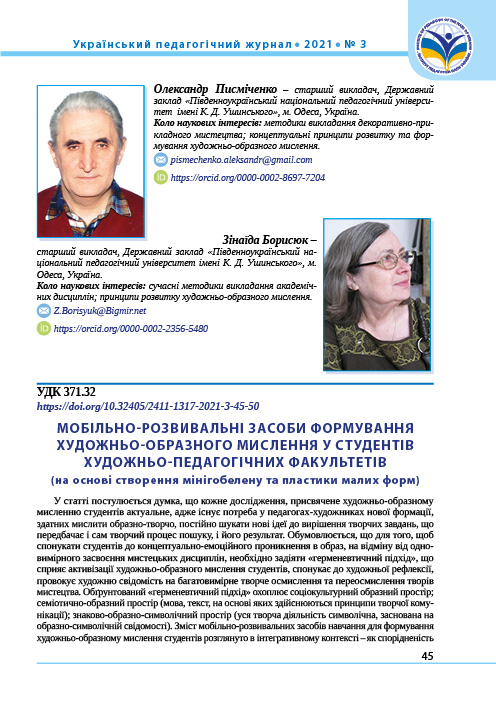Анотація
У статті постулюється думка, що кожне дослідження, присвячене художньо-образному мисленню студентів актуальне, адже існує потреба у педагогах-художниках нової формації, здатних мислити образно-творчо, постійно шукати нові ідеї до вирішення творчих завдань, що передбачає і сам творчий процес пошуку, і його результат. Обумовлюється, що для того, щоб спонукати студентів до концептуально-емоційного проникнення в образ, на відміну від одновимірного засвоєння мистецьких дисциплін, необхідно задіяти «герменевтичний підхід», що сприяє активізації художньо-образного мислення студентів, спонукає до художньої рефлексії, провокує художню свідомість на багатовимірне творче осмислення та переосмислення творів мистецтва. Обґрунтований «герменевтичний підхід» охоплює соціокультурний образний простір; семіотично-образний простір (мова, текст, на основі яких здійснюються принципи творчої комунікації); знаково-образно-символічний простір (уся творча діяльність символічна, заснована на образно-символічній свідомості). Зміст мобільно-розвивальних засобів навчання для формування художньо-образному мислення студентів розглянуто в інтегративному контексті – як спорідненість різних елементів розкриття багатоаспектності відображення розмаїтою «образною мовою» ліній, барв, що сприймаються за допомогою зору, слуху та інших органів чуття.
Посилання
К. Г. Юнг, Человек и его символы, Москва, 1997.
G. Bachelard, Le nouvel esprit scientifigue, Paris,1963.
Дж. Ділі, Основи семіотики. Львів. 2000.
Б. Ф. Ломов, Методологические и теоретические проблемы психологи, Москва, 1984.
А. А. Потебня, Слово и миф, Москва, 1989.
В. И. Ворников, Природа гносеологического образа в науке, Saarbruken, 2014.
Г. М. Падалка, Педагогіка мистецтва (Теорія і методика викладання, мистецьких дисциплін), Київ, 2008.
З. Фрейд, Художник и фантазирование. Москва.
Н. А. Банфи, Философия искусства, Москва, 1989.
Г. А. Голицын, «Образ как концентратор информации», Вопросы философии, 2000.
Е. С. Кубрякова, Язык и знание, Москва, 2004.
Л. Г. Медведев, Формирование графического художественного образа на занятиях по рисунку, Москва, 1984.
М. І. Стась, Методичні рекомендації з формування творчих здібностей майбутніх учителів образотворчого мистецтва, Черкаси, 2007.
Б. Т. Юсов, «Принципи побудови інтегрованих поліхудожніх програм з образотворчого мистецтва», Мистецтво і освіта, № 3, 2001.
K. G. Jung, Chelovek i ego simvoly, Moskva, 1997 (in Russian).
G. Bachelard, The new scientific spirit, Paris, 1963. (in French).
Dzh. Dili, Osnovy semiotyky. L`viv. 2000. . (in Ukrainian).
B. F. Lomov, Metodologicheskie i teoreticheskie problemy psihologi, Moskva, 1984. (in Russian).
A. A Potebnja, Slovo i mif, Moskva, 1989. (in Russian).
V. I. Vornikov, Priroda gnoseologicheskogo obraza v nauke, Saarbruken, 2014. (in Russian).
G. M. Padalka, Pedagogika mystecztva (Teoriya i metodyka vykladannya, mystecz`kyx dyscyplin), Kyyiv, 2008. (in Ukrainian).
Z. Frejd, Hudozhnik i fantazirovanie. Moskva. (in Russian).
N. A. Banfi, Filosofija iskusstva, Moskva, 1989. (in Russian).
G. A Golicyn, «Obraz kak koncentrator informacii», Voprosy filosofii, 2000. (in Russian).
E. S. Kubrjakova, Jazyk i znanie, Moskva, 2004. (in Russian).
L. G. Medvedev, Formirovanie graficheskogo hudozhestvennogo obraza na zanjatijah po risunku, Moskva, 1984. (in Russian).
M. I. Stas`, Metodychni rekomendaciyi z formuvannya tvorchyx zdibnostej majbutnix uchyteliv obrazotvorchogo mystecztva, Cherkasy, 2007. (in Ukrainian).
B. T. Yusov, «Pryncypy pobudovy integrovanyx polixudozhnix program z obrazotvorchogo mystecztva», Mystecztvo i osvita, № 3, 2001. (in Ukrainian).

Ця робота ліцензується відповідно до Creative Commons Attribution-NonCommercial-ShareAlike 4.0 International License.
Авторське право (c) 2021 Олександр Писміченко, Зінаїда Борисюк

